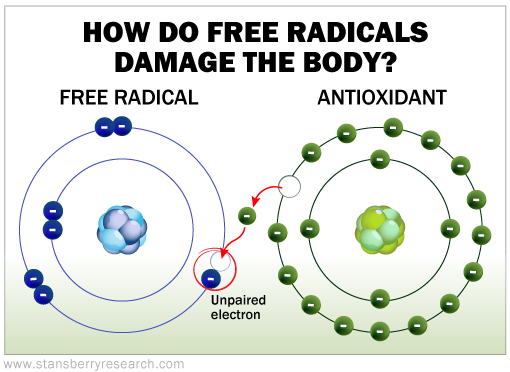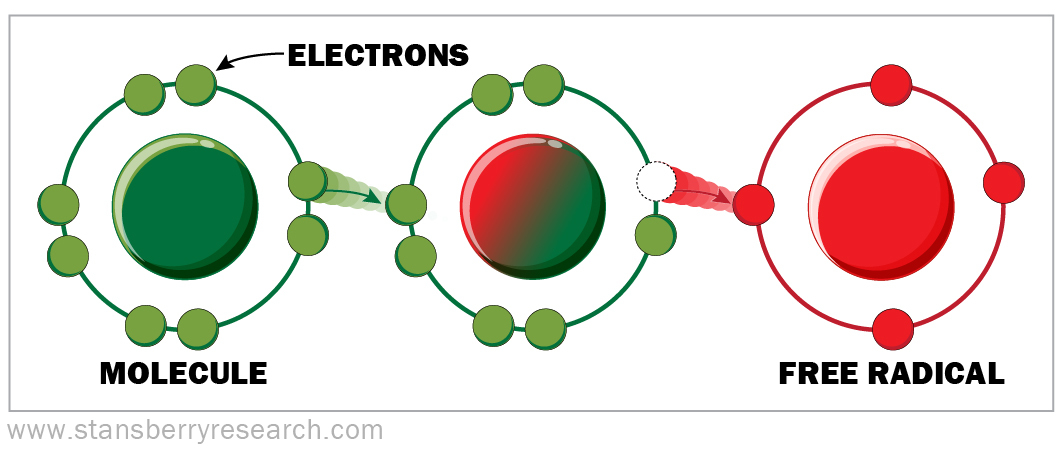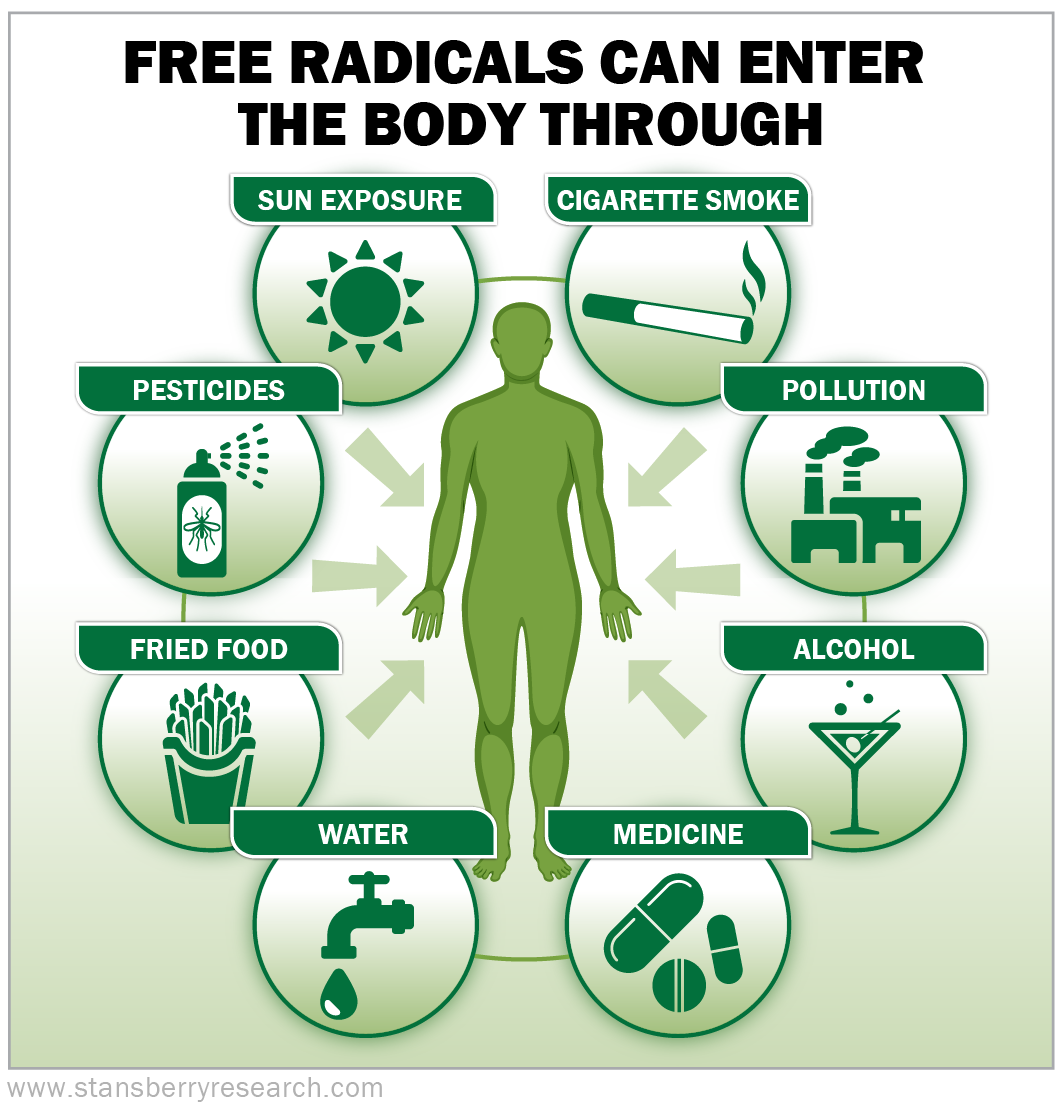Right now, you're fighting an invisible enemy...
Every day, there's a battle inside your body between your army of healthy cells and damaging molecules called "free radicals." These radicals bounce around your system, trying to pull electrons off healthy pieces of your cells. Too many free radicals can lead to massive damage. They alter your proteins, fats, and even DNA. They can cause inflammation and cancer.
The trouble is free radicals are byproducts of everyday living. Things like eating, drinking, going outside, and even breathing create free radicals.
What are they exactly, and how do they do so much damage?
In chemistry, we use the term "free radical" to describe the electronic structure of certain atoms that are also likely to create change (more on this in a moment).
It's not good to have too many free radicals, although they do have some benefits at times...
Our bodies spend all day waxing and waning between an array of chemical reactions. For example, our metabolism produces waste products that, when built up, too much can damage cells in the body. Many of these waste products are free radicals. These radicals come and go around the cells of our body and without them, life would be impossible.
Let's dive a bit deeper for a moment... Our cells are made up of tiny organic molecules with names you've certainly heard of: proteins, carbohydrates, fats, and DNA (and RNA). In turn, these molecules are made up of atoms.
Finally, these atoms are constructed from even smaller pieces: in the center there are protons (with a positive charge), neutrons (with no charge), and the electron on the outside. The electrons fly around the outside of the atom in an orbit.
These electron orbits surrounding our atoms in layers are called shells. For an atom to function properly, these shells need a specific number of electrons.
If an atom has an outer shell that isn't completely full of electrons, it can and does bond with another atom in a similar configuration in order to sort of complete its shell. This type of atom with a missing or an extra electron is a free radical.
The process of electrons migrating between cells is a common, everyday occurrence. It happens momentarily when your clothing touches your skin, and when your hands touch your keyboard.
Unstable atoms that are missing that final electron that would "complete the shell" become free radicals. It's this reactivity and desire to pair to electrons in other atoms that creates a chain of reactions. Eventually, these free radicals begin to damage cells, cause illness, and accelerate aging.
Please note that some free radicals are good... They can help the immune system to fight infection and perform other essential health functions.
Here's a picture of how antioxidants work by adding the needed electron to pair with the free radical. In turn, this settles that atom down.

A free radical pulls an electron from a nearby molecule. This causes the molecule to destabilize and become another free radical. This new free radical then pulls another electron from a molecule near it, creating a third free radical.

As this process continues, the cell containing these molecules begins to break down and change. When the cell's membrane becomes damaged, it remodels what can travel in and out of the cell.
Free radicals get created in the body through human interactions with...

Free radicals are also associated with aging. There is a theory that contends we age because of built-up free radical damage over a lifetime. It's known as the Free Radical Theory. Free radicals can damage our DNA's instructional code, cause new cells to grow incorrectly, and produce an aging effect.
What Is Oxidative Stress?
Oxidative stress occurs when free radicals overload your body and outnumber the antioxidants. Long-term oxidative stress damages the body's cells, proteins, and DNA.
An article in Pharmacognosy Review points out that oxidative stress damages your body's proteins, lipids, and nucleic acids.
Oxidative stress isn't always harmful, but it can cause chronic inflammation and neurodegenerative disease over time.
Several studies throughout the last few decades have also suggested that oxidative stress plays a role in the development of many conditions:
- Macular degeneration and cataracts
- Emphysema
- Ulcers
- Signs of advanced age, like wrinkles, hair loss, loss of skin elasticity, graying hair, and change in hair texture
- Autoimmune disease
- Arthritis and other inflammatory disorders
- Cancer
- Central nervous system diseases, like Alzheimer's disease and dementia
- Neurodegenerative diseases, like Parkinson's and Huntington's disease
- Diabetes
- High blood pressure
- Stroke
- Chronic fatigue syndrome
- Asthma
- Male infertility
You are at greater risk of developing oxidative stress if you:

Join us on Thursday when I'll explain just how to keep your free radicals balanced and working for you, rather than against you.
What We're Reading...
- A basic lesson on neutral versus charged objects.
- Something different: Why are farmers in Senegal creating gardens that look like crop circles?
Here's to our health, wealth, and a great retirement,
Dr. David Eifrig and the Health & Wealth Bulletin Research Team
September 7, 2021
